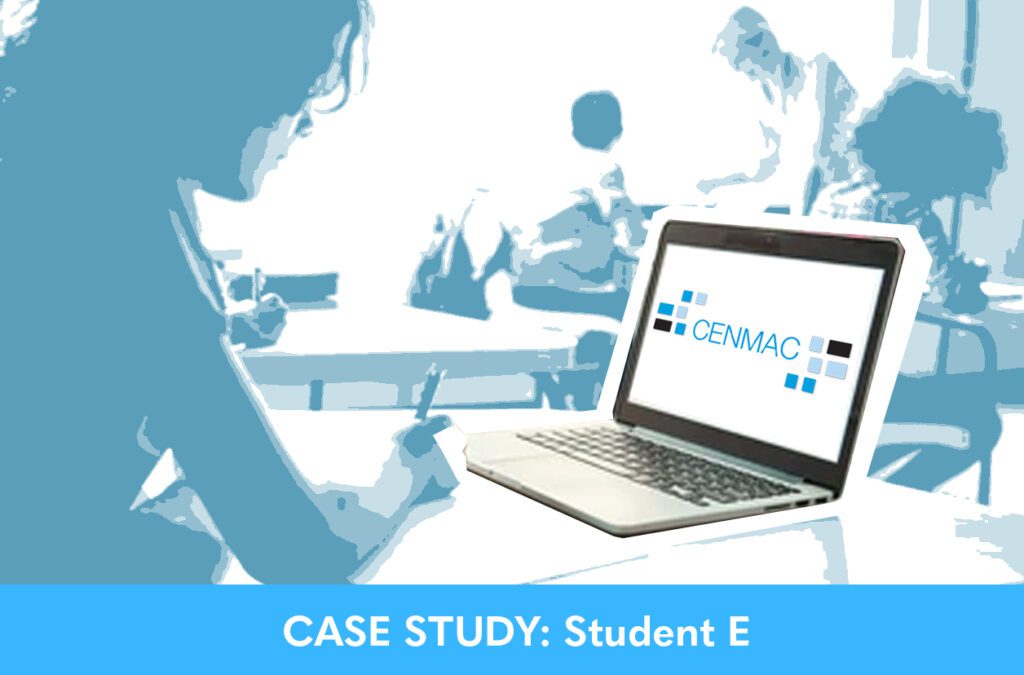Talents and Passions
Student E is a Year 10 student at a mainstream secondary school with an alternative resources provision. Student E has a deep interest in specialised subjects such as dinosaurs, the natural world, and biology. He is very knowledgeable, with an advanced vocabulary and understanding of technical terms related to his interests. Student E excels verbally but this is not matched by his ability to create pieces of writing which fully reflect his cognition.
Environment
Student E follows a mainstream curriculum and attends the alternative resources provision for certain lessons because he benefits from a calm, structured environment with minimal distractions.
He prefers to be seated near quiet and calm peers and likes to keep his personal belongings close to him. At school, he experiences high levels of anxiety when asked to complete long written tasks. He memorises his timetable for the day and can become very dysregulated if there are any changes to his daily routines. For example, having a supply teacher for a particular subject can be very challenging for him.

Trialling different technologies to support individual needs
To support his learning, Student E was initially provided with a Surface Pro laptop equipped with Office 365, including Dictate for voice-to-text functionality. He was initially reluctant to use any technology in the school setting, despite finding great success with these tools at home. He found the laptop too heavy to carry between classes and was anxious about using it at school. Organising his workspace at the start of each lesson caused him great anxiety, as did packing away at the end of the class and he feared being late for his next lessons.
At home, Student E has become proficient at using Microsoft voice-to-text tools and can now write longer pieces of writing this way. He did have some issues with the software saying that it ‘doesn’t understand him’, sometimes writing something different to what he intended. On these occasions, he can become overwhelmed and relies on support from his mum to help him edit his work. He has also become proficient at touch typing and this has helped him complete long written assignments at home without physical strain.
Recognising his need for more portable and accessible technology, Student E is now trialling an iPad with Dragon Dictation software. He is excited to use Dragon for capturing ideas more efficiently in class. The portable nature of the iPad means he can carry it around and pack it away independently. He likes using Dragon because he believes it makes fewer mistakes and so he does not need as much support from mum. He is motivated by the fact that it can be used in his GCSE exams.
Aims of the technology and support
The primary aim of the technology and support provided to Student E was to reduce his anxiety around writing and to enable him to complete written tasks that reflect his cognition. By introducing assistive technology like voice-to-text tools, the goal was to help Student E express his ideas in writing without the physical discomfort and stress caused by handwriting.
CENMAC’s support also aims to increase Student E’s independence in his learning by giving him the tools to complete tasks more confidently without the need for constant adult assistance. It is hoped that this will help Student E manage his anxiety and improve his academic performance, particularly in preparation for his GCSEs.
Impact and successes
Student E has made significant strides in several areas. His proficiency in using voice-to-text software at home has allowed him to complete longer written assignments without anxiety, demonstrating his ability to overcome barriers when given the right tools.
In school, Student E is more engaged in subjects that interest him, such as Geography, History, and Horticulture and he is now exploring new technologies like the iPad with Dragon Dictation to support his learning.
As a result of this greater confidence, Student E has also developed effective self-calming strategies and has formed a small group of friends, which has helped him build confidence in social settings. His willingness to trial new assistive technologies indicates his growing maturity and readiness to take more control of his learning journey.
Key Learnings
Personalised support is crucial
Student E’s case highlights the importance of personalised support tailored to the unique challenges and strengths of the student. Student E’s anxiety and sensitivities alongside his academic ability required tailored interventions.
Technology as a tool for accessibility
Student E’s experience shows how assistive technology can reduce barriers to learning if the correct tools are found. Tools like voice-to-text software helped him overcome the physical strain and anxiety associated with handwriting but it was important that he felt comfortable with the specific programs available.
The role of anxiety in learning
Student E’s challenges demonstrate how anxiety can be a significant barrier to learning and addressing his emotional and psychological barriers were as important as supporting the academic ones.
The Power of Strength-Based Approaches
Focusing on Student E’s strengths such as his passion for science, helped boost his engagement and confidence. It was important to identify and build on his strengths to motivate learning and foster positive outcomes.
The Importance of Self-Advocacy and Ownership
Student E showed that empowering students to take ownership of their learning tools can increase their independence and confidence. Although initially hesitant to use assistive technology in school, Student E became more open to trialling new tools as he matured and understood how they could help him.
Flexibility and willingness to adapt
Student E’s reluctance to use certain tools in school, contrasted with his comfort using them at home and highlighted the importance of remaining adaptable. Being flexible and trying new solutions, like switching from a Surface Pro to an iPad, made a big difference.
Patience leads to long-term progress
Student E’s gradual progress showed that success may not be immediate, but consistent, patient guidance can lead to meaningful, long-term development.
Case Study Author: Maureen De Longhi, CENMAC Advisory Teacher



